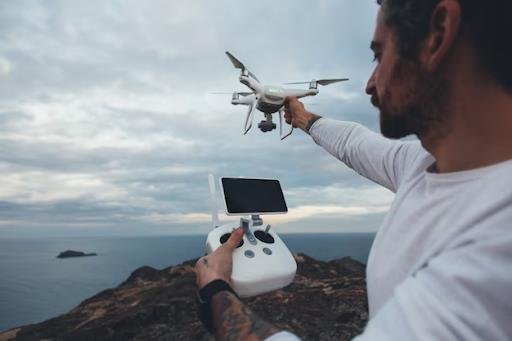Drones, once confined to military and professional use, have evolved into versatile tools that are transforming everyday life. From delivering packages to enhancing home security, drones are becoming an integral part of modern society. Their capabilities, affordability, and user-friendly technology make them accessible for various applications, opening new possibilities for businesses and individuals alike.
Understanding Drones and Their Capabilities
What Are Drones?
Drones, also known as unmanned aerial vehicles (UAVs), are remotely controlled or autonomous flying devices equipped with cameras, sensors, and other technologies. They come in various shapes and sizes, tailored to specific uses.
How Drones Work
Drones are powered by propellers and controlled through radio signals or apps. Advanced models feature GPS for navigation, cameras for imaging, and AI for autonomous decision-making. You can read more blogs about the same on trafficlike.com website.
Applications of Drones in Everyday Life
Revolutionizing Delivery Services
One of the most promising uses of drones is in package delivery. Companies like Amazon and UPS are testing drone delivery systems to reduce delivery times and costs.
- Speed and Efficiency: Drones can deliver packages within minutes, bypassing traffic and geographical barriers.
- Contactless Delivery: Especially relevant during the COVID-19 pandemic, drones enable safe, contactless delivery of essential items.
Enhancing Home Security
Drones are reshaping home security by providing advanced surveillance capabilities.
- Aerial Monitoring: Equipped with high-resolution cameras, drones can patrol properties, monitor blind spots, and detect intrusions.
- Real-Time Alerts: Drones integrated with smart home systems can send live feeds and alerts to homeowners’ devices, enhancing safety.
Transforming Agriculture
In agriculture, drones are used for precision farming, helping farmers optimize resources and monitor crops.
- Crop Surveillance: Drones can assess crop health using thermal imaging and NDVI (Normalized Difference Vegetation Index) sensors.
- Pest Control and Spraying: Specialized drones spray pesticides or fertilizers with pinpoint accuracy, reducing waste and environmental impact.
Improving Emergency Response
Drones are proving invaluable in disaster management and emergency response.
- Search and Rescue: Drones equipped with thermal cameras can locate missing persons in difficult terrain.
- Medical Supply Delivery: In emergencies, drones can deliver medical supplies or defibrillators to remote or inaccessible areas.
Enabling Aerial Photography and Videography
For hobbyists and professionals, drones offer stunning perspectives for photography and filmmaking.
- Creative Freedom: Drones allow users to capture unique angles, panoramic views, and dynamic shots.
- Cost-Effective Filming: Compared to helicopters, drones are a more affordable option for aerial cinematography.
Benefits of Everyday Drone Use
Convenience
Drones simplify tasks that were previously time-consuming or labor-intensive, such as property inspections, deliveries, or monitoring large areas.
Cost Efficiency
Drones reduce the need for expensive infrastructure or equipment. For example, drones replace manned aircraft for aerial surveys and inspections.
Accessibility
With advancements in technology, drones are now more affordable and user-friendly, making them accessible to a wider audience.
Safety
Drones minimize human risk in hazardous tasks, such as inspecting power lines, fighting fires, or responding to disasters.
Future Trends in Drone Technology
Autonomous Drones
The next generation of drones will feature advanced AI, enabling them to operate without human intervention for tasks like delivery, mapping, and surveillance.
Swarm Technology
Swarm drones, operating in coordinated groups, will revolutionize industries such as agriculture, disaster management, and crowd monitoring.
Enhanced Battery Performance
Improvements in battery technology will enable drones to fly longer distances and perform more demanding tasks.
5G Integration
With 5G networks, drones will benefit from real-time communication, faster data transmission, and improved navigation systems.
How to Choose the Right Drone for Everyday Use
Identify Your Needs
Consider the purpose of the drone—whether for delivery, security, photography, or personal recreation. Different drones are optimized for different applications. Additionally, you can read more on trafficlike site.
Check Features
Look for essential features such as GPS, camera quality, flight range, and battery life. Advanced models may include AI, obstacle avoidance, and weather resistance.
Understand Regulations
Ensure you are familiar with local laws governing drone usage, including no-fly zones and licensing requirements.
Budget Considerations
Drones range from budget-friendly models for beginners to high-end options for professionals. Choose a model that fits your requirements and budget.
Conclusion
Drones are rapidly becoming indispensable tools in everyday life, offering solutions that improve efficiency, safety, and convenience. From delivering packages to securing homes, their versatility and technological advancements promise even greater integration into daily activities. As technology continues to evolve, drones will unlock new opportunities, revolutionizing industries and reshaping how we interact with the world around us.
